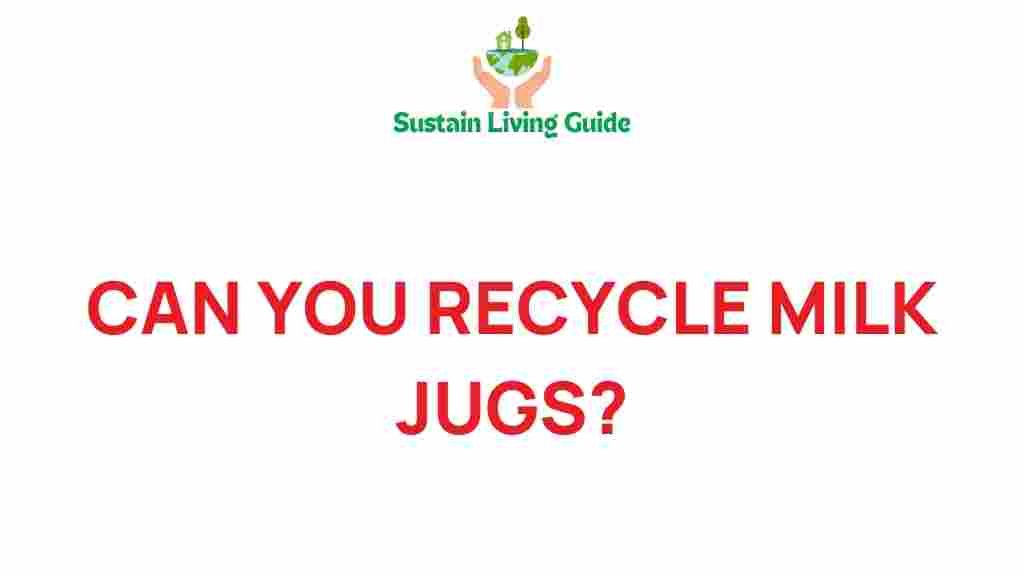The Surprising Truth About Recycling Milk Jugs: What You Need to Know About Recycling
In today’s environmentally conscious world, recycling has become more important than ever. Among the many items we use daily, milk jugs are a significant part of our waste stream. While many people are aware of the need to recycle, few understand the intricacies involved in recycling milk jugs. This article uncovers the surprising truths about recycling milk jugs and provides essential information you need to make a positive impact.
Why Recycling Milk Jugs Matters
Recycling milk jugs is crucial for several reasons:
- Resource Conservation: Recycling helps conserve valuable natural resources, such as petroleum, which is used to produce new plastic.
- Energy Savings: The recycling process requires less energy compared to creating new products from raw materials.
- Landfill Reduction: By recycling milk jugs, we can significantly reduce the amount of plastic waste that ends up in landfills.
- Environmental Protection: Recycling helps decrease pollution and greenhouse gas emissions, contributing to a healthier planet.
What Are Milk Jugs Made Of?
Most milk jugs are made from high-density polyethylene (HDPE), which is a type of plastic known for its strength and durability. This material is marked with the recycling code “2,” making it one of the most widely recycled plastics. Understanding the composition of milk jugs is essential for effective recycling.
Step-by-Step Process of Recycling Milk Jugs
Recycling milk jugs is a straightforward process, but it does require some preparation. Here’s a step-by-step guide to ensure your milk jugs are ready for recycling:
1. Rinse and Clean
Before recycling, it’s essential to rinse out any remaining milk or residue from the jug. Here’s how to do it:
- Fill the jug with a small amount of water.
- Shake it well and pour the water out.
- Repeat if necessary until the jug is clean.
Cleaning the jug helps prevent contamination, which can affect the recycling process.
2. Remove the Cap
Most recycling programs require that the caps be removed from milk jugs before recycling. Here’s what to do:
- Twist off the cap and set it aside.
- Discard the cap according to your local recycling guidelines, as they may have different recycling categories.
3. Flatten the Jug
Flattening the jug can save space in your recycling bin. However, check with your local recycling program to ensure this is acceptable.
4. Check Local Guidelines
Recycling rules can vary by location. Always check your local recycling guidelines to ensure you’re following the correct procedures. You can find this information on your municipality’s website or by visiting Recycling Partnership.
Troubleshooting Common Recycling Issues
Even with the best intentions, mistakes can happen when recycling milk jugs. Here are some common issues and how to troubleshoot them:
1. Contamination
Contaminated recyclables can lead to entire batches being sent to a landfill. If you notice that your recycling is not being accepted, consider the following:
- Ensure all items are clean and dry before placing them in your recycling bin.
- Avoid mixing recyclables with non-recyclables.
2. Not Knowing What to Recycle
It’s common to be unsure about what can and cannot be recycled. If you’re in doubt:
- Refer to local recycling guides.
- Look for recycling symbols on items.
3. Improperly Disposed Caps
As mentioned earlier, the caps on milk jugs often need to be discarded separately. If you accidentally included them:
- Check if they can be recycled separately.
- Learn about proper disposal methods for caps to ensure they don’t end up in landfills.
Benefits of Recycling Milk Jugs
Recycling milk jugs offers numerous benefits, both environmentally and economically. Here are some of the key advantages:
- Reduces Plastic Production: By recycling, we help reduce the demand for new plastic production, which can be harmful to the environment.
- Creates Jobs: The recycling industry creates jobs in collection, processing, and manufacturing.
- Supports the Circular Economy: Recycling contributes to a circular economy, where materials are reused rather than discarded.
Innovative Uses for Recycled Milk Jugs
Once milk jugs are recycled, they can be transformed into a variety of new products. Here are some innovative uses for recycled milk jugs:
- New Plastic Products: Recycled HDPE can be used to create new containers, plastic lumber, and piping.
- Textiles: Some recycled plastics are converted into fibers for clothing and carpets.
- Garden Products: Recycled milk jugs can be used to make items like planters and compost bins.
The Role of Consumer Education
Consumer education plays a vital role in improving recycling rates. Here are some ways to enhance your knowledge and share it with others:
- Attend Workshops: Participate in local workshops on recycling and sustainability.
- Read Up: Keep informed through reputable sources about recycling practices.
- Share Information: Educate friends and family about the importance of recycling.
Conclusion
Recycling milk jugs is an essential practice that contributes significantly to environmental sustainability. By understanding the correct recycling processes, troubleshooting common issues, and recognizing the benefits, we can all play a part in reducing waste and conserving resources. Remember, every small action counts in the broader effort to protect our planet.
For more information on recycling practices and tips, visit Earth911 and stay engaged in making our world a cleaner, greener place.
By following the guidelines outlined in this article, you can ensure that your recycling efforts are effective and impactful. Together, we can make a difference!
This article is in the category Waste and created by SustainLivingGuide Team
